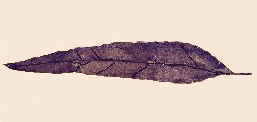 |
Division CHLOROPHYCOPHYTA
(green algae)
 Green
algae along with brown (Division Phaeophycophyta) and red algae (Division
Rhodophycophyta) are ancient groups that date back to Archean time (over
3 billion yrs. ago). Masses of algal mats trap sediments and have collectively
been known as stromatolites. Green
algae along with brown (Division Phaeophycophyta) and red algae (Division
Rhodophycophyta) are ancient groups that date back to Archean time (over
3 billion yrs. ago). Masses of algal mats trap sediments and have collectively
been known as stromatolites.
Division BRYOPHYTA (the mosses,
hornworts, and liverworts)
They are the most primitive of green plants and are not important in
the geological record.
|
Division TRACHEOPHYTA
These are the vascular plants with well developed conductive tissues
which carry water and organic materials.
|
Subdivision PSYLOPHYTA
(the psylophytes)
These are the earliest and most primitive plants. They were small,
one foot or less, branched, seedless, and were not differentiated into
roots, stems and leaves. Some botanists separate the early fossil
plants from the Psylophytes and give them a separate subdivision, although
this arrangement is not followed here.
|
Subdivision LYCOPODOPHYTA
(the lycophytes)
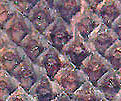 This
group separated early into two major evolutionary lines. One line,
the club mosses remained grasslike. The other line, the Lepidodendrales
became one of the dominant forms in the coal forest of the Carboniferous
and became extinct at the end of the Permian. Fossil trunks and roots
show characteristic leaf and rootlet scars. More
Lycophytes This
group separated early into two major evolutionary lines. One line,
the club mosses remained grasslike. The other line, the Lepidodendrales
became one of the dominant forms in the coal forest of the Carboniferous
and became extinct at the end of the Permian. Fossil trunks and roots
show characteristic leaf and rootlet scars. More
Lycophytes
|
Subdivision SPHENOPHYTA
(the sphenophytes)
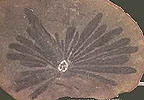 Their
record extends back to the Permian. This group also was an important
component of the Carboniferous coal forests, with some members reaching
over 50' in height. In general appearance they resembled (except
for size) the modern horsetail Equisetum. The jointed trunk
pattern seen in Calamites is characteristic of the group. Their
record extends back to the Permian. This group also was an important
component of the Carboniferous coal forests, with some members reaching
over 50' in height. In general appearance they resembled (except
for size) the modern horsetail Equisetum. The jointed trunk
pattern seen in Calamites is characteristic of the group.
|
Subdivision FILICOPHYTA (the true ferns)
Although they are common members of many floras they do not have great
geological importance.
|
Subdivision SPERMATOPHYTA (the spermatophytes
or seed plants)
The first four classes which follow are often called the gymnosperms
or plants with naked seeds.
|
Class PTERIDOSPERMOPHYTA
(the pteridosperms)
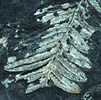 The
pteridosperms are often referred to as seed ferns. These plants have
a fern-like foliage, but, in contrast to true ferns, they bear seeds.
They were the most common components of the great coal forests of the Carboniferous. The
pteridosperms are often referred to as seed ferns. These plants have
a fern-like foliage, but, in contrast to true ferns, they bear seeds.
They were the most common components of the great coal forests of the Carboniferous.
More pteridosperms
|
Class CONIFEROPHYTA
(conifers, pines, junipers, spruces, larches, cypresses, and redwoods)
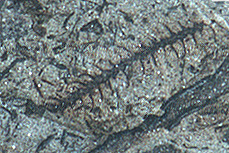 Most
people are familiar with this class. Then, as now, they were the
largest and often the most common components of forests. They were
most common in the Mesozoic. Most
people are familiar with this class. Then, as now, they were the
largest and often the most common components of forests. They were
most common in the Mesozoic.
More conifers
|
Class CYCADOPHYTA
(the cycads)
 The
cycads bear a superficial resemblance to palms. A common ornamental cycad
in the South (Cycas revolutus) is called a Sago Palm.
They were so common in the Mesozoic that this period of time is often called
the Age of Cycads. They were one of the foods for herbivorous dinosaurs.
They are much less common now. The
cycads bear a superficial resemblance to palms. A common ornamental cycad
in the South (Cycas revolutus) is called a Sago Palm.
They were so common in the Mesozoic that this period of time is often called
the Age of Cycads. They were one of the foods for herbivorous dinosaurs.
They are much less common now.
|
Class GINKGOPHYTA
(the ginkgoes or maidenhair trees)
Maidenhair trees were common in the Mesozoic as a class, but are represented
by only a single species now. The leaf shape of this class is quite
distinctive.
|
Class ANGIOSPERMOPHYTA (the flowering
plants)
As the name indicates, they bear flowers. They appear in Cretaceous
time and their rapid evolutionary rise has made them the dominant component
of modern floras. Their association with insects is essential. Some
65% of flowering plants depend on insects for pollination and hence reproduction.
There are two subclasses of flowering plants:
|
Subclass MONOCOTYLEDONAE,
the
monocots: palms, orchids, grasses and cereals
|
Subclass DICOTYLEDONAE,
the
dicots: which includes most broad leaf trees.
|
 Green
algae along with brown (Division Phaeophycophyta) and red algae (Division
Rhodophycophyta) are ancient groups that date back to Archean time (over
3 billion yrs. ago). Masses of algal mats trap sediments and have collectively
been known as stromatolites.
Green
algae along with brown (Division Phaeophycophyta) and red algae (Division
Rhodophycophyta) are ancient groups that date back to Archean time (over
3 billion yrs. ago). Masses of algal mats trap sediments and have collectively
been known as stromatolites. This
group separated early into two major evolutionary lines. One line,
the club mosses remained grasslike. The other line, the Lepidodendrales
became one of the dominant forms in the coal forest of the Carboniferous
and became extinct at the end of the Permian. Fossil trunks and roots
show characteristic leaf and rootlet scars. More
Lycophytes
This
group separated early into two major evolutionary lines. One line,
the club mosses remained grasslike. The other line, the Lepidodendrales
became one of the dominant forms in the coal forest of the Carboniferous
and became extinct at the end of the Permian. Fossil trunks and roots
show characteristic leaf and rootlet scars. More
Lycophytes Their
record extends back to the Permian. This group also was an important
component of the Carboniferous coal forests, with some members reaching
over 50' in height. In general appearance they resembled (except
for size) the modern horsetail Equisetum. The jointed trunk
pattern seen in Calamites is characteristic of the group.
Their
record extends back to the Permian. This group also was an important
component of the Carboniferous coal forests, with some members reaching
over 50' in height. In general appearance they resembled (except
for size) the modern horsetail Equisetum. The jointed trunk
pattern seen in Calamites is characteristic of the group.  The
cycads bear a superficial resemblance to palms. A common ornamental cycad
in the South (Cycas revolutus) is called a Sago Palm.
They were so common in the Mesozoic that this period of time is often called
the Age of Cycads. They were one of the foods for herbivorous dinosaurs.
They are much less common now.
The
cycads bear a superficial resemblance to palms. A common ornamental cycad
in the South (Cycas revolutus) is called a Sago Palm.
They were so common in the Mesozoic that this period of time is often called
the Age of Cycads. They were one of the foods for herbivorous dinosaurs.
They are much less common now.

